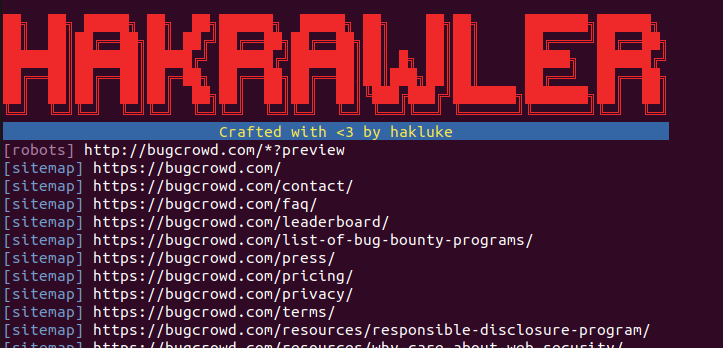No products in the cart.

Fast golang web crawler for gathering URLs and JavaScript file locations. This is basically a simple implementation of the awesome Gocolly library. Example usages Single URL: echo https://google.com | hakrawler Multiple URLs: cat urls.txt | hakrawler Timeout for each line of stdin after 5 seconds: cat urls.txt | hakrawler -timeout 5 Send all requests through a proxy: cat urls.txt | hakrawler -proxy https://localhost:8080 Include subdomains: echo https://google.com | hakrawler -subs Note: a common issue is that the tool returns no URLs. This usually happens when a domain is specified (https://example.com), but it redirects to a subdomain (https://www.example.com). The subdomain is not included in the scope, so the no URLs are printed. In order to overcome this, either specify the final URL in the redirect chain or use the -subs option to include subdomains. Example toolchain Get all subdomains of google, find the ones that respond to http(s), and crawl them....
A very big thanks to kelvinethicalhacker at gmail com for the great the work you done for me, i got the email address on the net web when i needed to hack my husband cell phone he helped me within few hours with whatsApp hacking and GPS location tracking direct from my person phone i know how my husband walks, thanks for the helped you do for me for every grateful for your helped, you can contact him through gmail via kelvinethicalhacker at gmail.com or Telegram, calls, text, number +1(341)465-4599, if you are in needed of hacking services, contact him.
It was a few days ago when I discovered my spouse was hiding a lot of things from me and I needed to gain access to the device, I went on Google and saw (kelvinethicalhacker at gmail.com). and it was a great experience, I got access and saw everything my partner was hiding. This life is just amazing.
A great hacker is really worthy of good recommendation , Henry
really help to get all the evidence i needed against my husband and
and i was able to confront him with this details from this great hacker
to get an amazing service done with the help ,he is good with what he does and the charges are affordable, I think all I owe him is publicity for a great work done via, Henryclarkethicalhacker at gmail com, and you can text, call him on whatsapp him on +12014305865, or +17736092741,